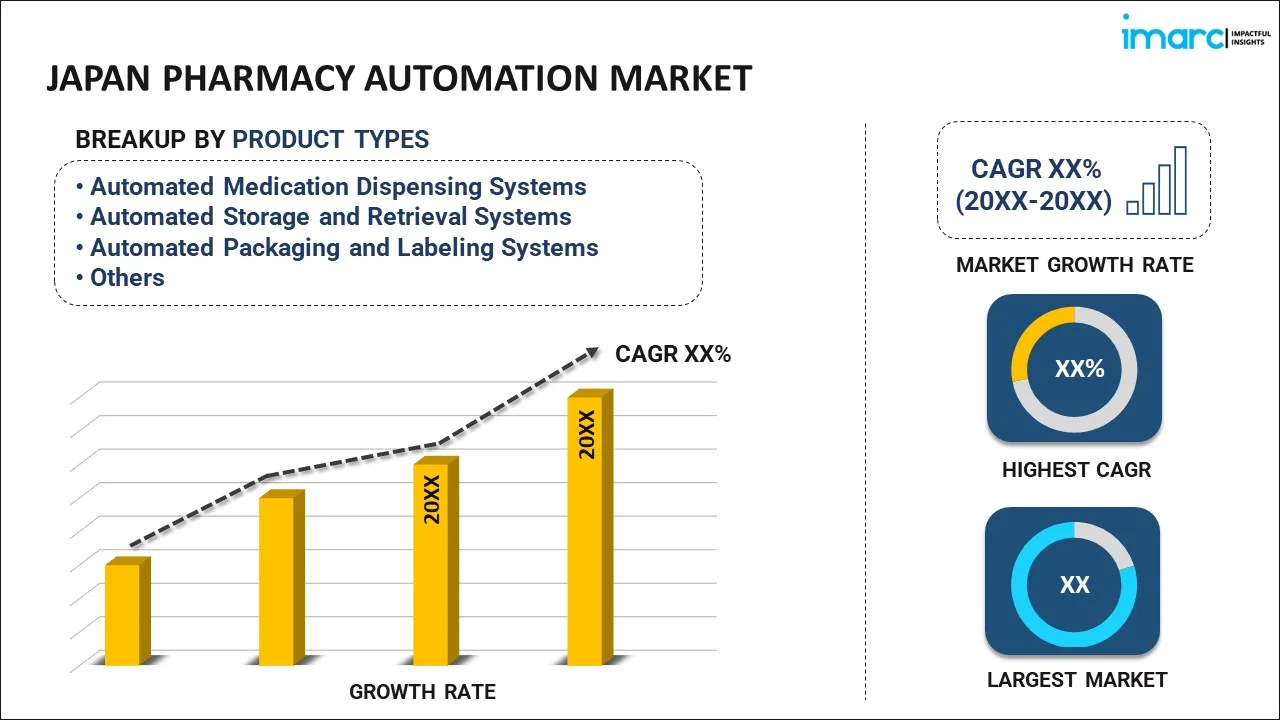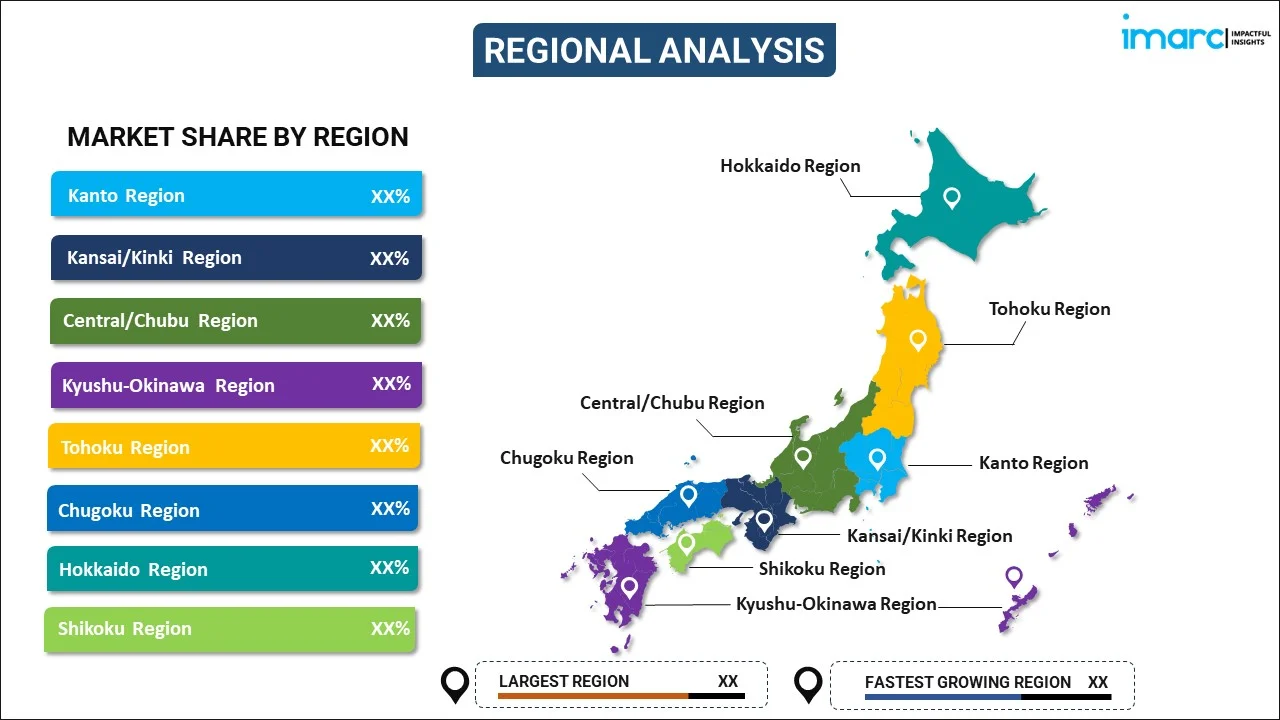
Japan Pharmacy Automation Market Report by Product Type (Automated Medication Dispensing Systems, Automated Storage and Retrieval Systems, Automated Packaging and Labeling Systems, Tabletop Tablet Counters, and Others), Application (Drug Dispensing and Packaging, Drug Storage, Inventory Management), End User (Hospital Pharmacies, Retail Pharmacies, and Others), and Region 2025-2033
Market Overview:
Japan pharmacy automation market size reached USD 368.5 Million in 2024. Looking forward, IMARC Group expects the market to reach USD 1,236.7 Million by 2033, exhibiting a growth rate (CAGR) of 13.2% during 2025-2033. The market is being driven by several significant factors, including a rising demand for error reduction in medical procedures, an increasing prevalence of chronic illnesses, and various advancements in robotics, artificial intelligence, machine learning, and data analytics.
|
Report Attribute
|
Key Statistics
|
|---|---|
|
Base Year
|
2024
|
|
Forecast Years
|
2025-2033
|
|
Historical Years
|
2019-2024
|
| Market Size in 2024 | USD 368.5 Million |
| Market Forecast in 2033 | USD 1,236.7 Million |
| Market Growth Rate 2025-2033 | 13.2% |
Pharmacy automation involves leveraging technology and automated systems to optimize and enhance different facets of pharmacy operations. This encompasses the utilization of robotic devices, computerized systems, and software applications to execute tasks that were conventionally undertaken manually by pharmacists and pharmacy personnel. Its primary objectives are to elevate the precision, efficiency, and safety of activities like medication dispensing, inventory control, prescription fulfillment, and various other pharmaceutical procedures. These solutions deliver multiple advantages, including heightened patient safety, decreased medication errors, enhanced operational efficiency, improved inventory oversight, and streamlined workflows for pharmacy staff.
Japan Pharmacy Automation Market Trends:
The market is primarily being propelled by the increasing imperative to minimize errors in medical procedures. Additionally, as the population ages and the prevalence of chronic illnesses continues to grow, there is a heightened demand for prescription medications. Pharmacy automation empowers pharmacies to efficiently manage larger prescription volumes, ensuring prompt dispensing and decreasing patient waiting times. Furthermore, the implementation of various government policies aimed at enhancing the quality of healthcare facilities is also contributing to market expansion. Moreover, ongoing technological advancements are resulting in higher success rates post-treatment and surgeries, as well as the delivery of more effective patient care, thus creating a positive market outlook. Pharmacy automation plays a crucial role in enhancing patient safety by reducing the risk of medication errors, improving accuracy in the dispensing process, and providing clear medication labeling. Besides this, data analytics tools have the capability to examine patterns in medication usage, detect trends, and enhance inventory management. These analytical insights enable pharmacies to base their decisions on data, such as making adjustments to stock levels, recognizing medication dispensing patterns, and enhancing operational efficiency, thereby driving market expansion. The utilization of automated prescription refill systems and medication packaging also enhances convenience for patients, simplifying access to and management of their medications. This, in turn, is anticipated to fuel the market growth over the forecasted period.
Japan Pharmacy Automation Market Segmentation:
IMARC Group provides an analysis of the key trends in each segment of the market, along with forecasts at the country level for 2025-2033. Our report has categorized the market based on product type, application, and end user.
Product Type Insights:

- Automated Medication Dispensing Systems
- Automated Storage and Retrieval Systems
- Automated Packaging and Labeling Systems
- Tabletop Tablet Counters
- Others
The report has provided a detailed breakup and analysis of the market based on the product type. This includes automated medication dispensing systems, automated storage and retrieval systems, automated packaging and labeling systems, tabletop tablet counters, and others.
Application Insights:
- Drug Dispensing and Packaging
- Drug Storage
- Inventory Management
A detailed breakup and analysis of the market based on the application have also been provided in the report. This includes drug dispensing and packaging, drug storage, and inventory management.
End User Insights:
- Hospital Pharmacies
- Retail Pharmacies
- Others
The report has provided a detailed breakup and analysis of the market based on the End User. This includes hospital pharmacies, retail pharmacies, and others.
Regional Insights:

- Kanto Region
- Kansai/Kinki Region
- Central/ Chubu Region
- Kyushu-Okinawa Region
- Tohoku Region
- Chugoku Region
- Hokkaido Region
- Shikoku Region
The report has also provided a comprehensive analysis of all the major regional markets, which include Kanto Region, Kansai/Kinki Region, Central/ Chubu Region, Kyushu-Okinawa Region, Tohoku Region, Chugoku Region, Hokkaido Region, and Shikoku Region.
Competitive Landscape:
The market research report has also provided a comprehensive analysis of the competitive landscape. Competitive analysis such as market structure, key player positioning, top winning strategies, competitive dashboard, and company evaluation quadrant has been covered in the report. Also, detailed profiles of all major companies have been provided.
Japan Pharmacy Automation Market Report Coverage:
| Report Features | Details |
|---|---|
| Base Year of the Analysis | 2024 |
| Historical Period | 2019-2024 |
| Forecast Period | 2025-2033 |
| Units | Million USD |
| Scope of the Report | Exploration of Historical and Forecast Trends, Industry Catalysts and Challenges, Segment-Wise Historical and Predictive Market Assessment:
|
| Product Types Covered | Automated Medication Dispensing Systems, Automated Storage and Retrieval Systems, Automated Packaging and Labeling Systems, Tabletop Tablet Counters, Others |
| Applications Covered | Drug Dispensing and Packaging, Drug Storage, Inventory Management |
| End Users Covered | Hospital Pharmacies, Retail Pharmacies, Others |
| Regions Covered | Kanto Region, Kansai/Kinki Region, Central/ Chubu Region, Kyushu-Okinawa Region, Tohoku Region, Chugoku Region, Hokkaido Region, Shikoku Region |
| Customization Scope | 10% Free Customization |
| Post-Sale Analyst Support | 10-12 Weeks |
| Delivery Format | PDF and Excel through Email (We can also provide the editable version of the report in PPT/Word format on special request) |
Key Questions Answered in This Report:
- How has the Japan pharmacy automation market performed so far and how will it perform in the coming years?
- What has been the impact of COVID-19 on the Japan pharmacy automation market?
- What is the breakup of the Japan pharmacy automation market on the basis of product type?
- What is the breakup of the Japan pharmacy automation market on the basis of application?
- What is the breakup of the Japan pharmacy automation market on the basis of end user?
- What are the various stages in the value chain of the Japan pharmacy automation market?
- What are the key driving factors and challenges in the Japan pharmacy automation?
- What is the structure of the Japan pharmacy automation market and who are the key players?
- What is the degree of competition in the Japan pharmacy automation market?
Key Benefits for Stakeholders:
- IMARC’s industry report offers a comprehensive quantitative analysis of various market segments, historical and current market trends, market forecasts, and dynamics of the Japan pharmacy automation market from 2019-2033.
- The research report provides the latest information on the market drivers, challenges, and opportunities in the Japan pharmacy automation market.
- Porter's five forces analysis assist stakeholders in assessing the impact of new entrants, competitive rivalry, supplier power, buyer power, and the threat of substitution. It helps stakeholders to analyze the level of competition within the Japan pharmacy automation industry and its attractiveness.
- Competitive landscape allows stakeholders to understand their competitive environment and provides an insight into the current positions of key players in the market.
Need more help?
- Speak to our experienced analysts for insights on the current market scenarios.
- Include additional segments and countries to customize the report as per your requirement.
- Gain an unparalleled competitive advantage in your domain by understanding how to utilize the report and positively impacting your operations and revenue.
- For further assistance, please connect with our analysts.
 Inquire Before Buying
Inquire Before Buying
 Speak to an Analyst
Speak to an Analyst
 Request Brochure
Request Brochure
 Request Customization
Request Customization




.webp)




.webp)












